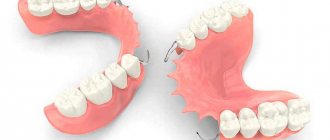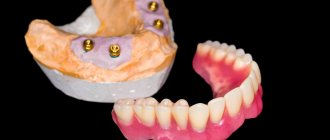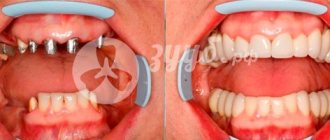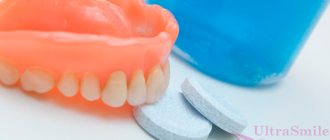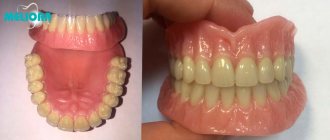The restoration of damaged or removed teeth is carried out by an orthopedic dentist.
This specialist can offer only one, but very effective way to solve the problem - installation of prosthetic structures. At the same time, one or two visits to the clinic will not be enough: the recovery method involves a multi-stage approach. Let's look at the main stages of dental prosthetics, which consistently bring the patient closer to the main goal: gaining a beautiful smile and the ability to chew food normally.
Survey
Diagnostics helps to accurately assess the condition of teeth, gums, and facial bones and determine the optimal method of treating edentulism. To do this, the dentist:
- Interviews the patient and listens to complaints.
- Examines all organs of the oral cavity - teeth, gums, tongue.
- Prescribes radiography or CT (computed tomography).
The images help determine whether the teeth adjacent to the defect are suitable for use as supports. Sometimes, after radiography, it also turns out that adjacent units are not suitable for adjacent implants or bridges.
What is the cost of dental implants?
The process of dental implantation is quite complex, with many subtleties and nuances. Therefore, its price is appropriate. In dentistry, the minimum cost of a South Korean implant and its installation is 18,000 rubles. It comes with a five-year warranty, but with adequate care it will last you a lifetime. German implants are more expensive - from 30,000 rubles, but they have a lifetime guarantee. The cost of implants for a one-step technique is 36,000 rubles. The price list of premium level products starts from 42,000 rubles. Additional manipulations, such as bone grafting, are paid separately. Bone tissue augmentation costs from 18,000 rubles to 40,000 rubles, depending on the complexity of the operation. The cost of a temporary crown is 12,000 rubles, a permanent one - from 18,000 to 34,000 rubles. Dentures on implants cost from 64,000 to 190,000 rubles.
Preparation for installation of prostheses
After diagnosis, the doctor explains the clinical situation to the patient and proposes a plan for further action. In particular, he tells where to start with dental prosthetics, recommends and agrees on the method, and suggests types of structures. After this, the preparation of the oral cavity for their installation begins:
- Treatment of caries and pulpitis is carried out if these diseases are detected during the diagnostic process.
- Pathological changes in soft tissues that may become an obstacle to prosthetics are identified and eliminated.
- Depulpation (removal of the dental nerve) is performed if there are indications for it. For example, such manipulation may be necessary to prepare teeth for the installation of single crowns or bridge structures.
- The hard tissues of the supporting teeth are prepared. The dentist removes a layer of enamel and dentin in order to form a tooth stump for the crown.
- The remaining part of the tooth is strengthened. For this purpose, stump inlays or pins can be installed.
One of the stages of preparation for prosthetics may also be the installation of dental implants, which will become supports for crown-like or bridge structures.
Prosthetic methods for edentulous patients
There are three ways to restore the integrity of the dentition - using:
- removable dentures;
- conditionally removable dentures;
- fixed dentures – replenishment of the dentition with the help of implants: full or partial + installation of missing elements in the form of bridges or dentures.
Removable prosthetics
Many people choose it solely because of its affordable cost. A product made from the highest quality material, for example, “Kandulor” (Switzerland), costs on average no more than 40,000-50,000 rubles. Acrylic prostheses, familiar to many, will generally cost no more than 20,000 rubles.
Affordable price is one of the main advantages of removable prosthetics. You can also note:
- Good aesthetics - if you don’t look closely, “plastic” teeth look quite natural. The same can be said about the section of the structure that covers the gum.
- Easy to use - took it off, carefully cleaned it (ordinary toothpaste will do), put it in a container with water, and put it on in the morning.
Based on materials, removable dentures are divided into:
- acrylic;
- nylon;
- Acry-Free.
Acrylic
Such “jaws” have been made before. Now the technology for their production has improved, and the appearance has become much more attractive. And yet the designs have many disadvantages. This:
- allergy to the monomer contained in the material (acrylic);
- fragility;
- almost complete lack of elasticity;
- poor fixation;
- long period of adaptation.
However, such prostheses can be easily repaired. In the absence of sufficient funds, dentists recommend acrylic “jaws” to their patients
Nylon
The complete opposite of acrylic. They look beautiful - almost invisible, elastic - they are difficult to break, easy to get used to and easy to wear, hypoallergenic. However, the disadvantages are significant:
- when wearing nylon dentures, gum atrophy occurs;
- the service life of the material is short - it loses color quite quickly;
- If it breaks, it cannot be repaired - you will have to order a new product.
Acry-Free
Modern dentures are made of hypoallergenic material (do not contain acrylic), which fit perfectly on the gums in the absence of teeth - no special glue is required for fixation. Other advantages include simple restoration in case of breakdown, minimum service life without loss of aesthetic characteristics - 5 years. Compared to nylon dentures, Acry-Free dentures are stiffer and will take longer to get used to, but they make it possible to chew even rough food efficiently. The downside is that, like any other removable structures, they poorly distribute the load when chewing, causing gum atrophy.
Conditionally removable prosthetics
Most patients never fully get used to the removable “jaws”:
- When chewing, pieces of food may get underneath them.
- When you sneeze, if you do not cover your mouth with your hand, the structure can easily fly out.
- When you smile, the lower “jaw” of a removable denture can easily rise, which is completely unaesthetic.
The solution may be, in the absence of contraindications, conditionally removable structures or clasp dentures. Their distinctive feature is a minimum of plastic and a metal base. The patient will not have to get used to a foreign object covering the palate. In addition, such a design fits like a glove, because it is fixed either to your own surviving dental units - a pair on each jaw is enough, or to installed implants. The latter are:
- classical - if a lack of spongy gum tissue is detected in which such an implant is installed, a sinus lift operation is performed;
- basal – installed in dense bone, sinus lift surgery is not needed;
- mini - many dentists consider it as a temporary support for clasps; such implants will not withstand significant loads.
On a note. When replacing jaw prosthetics in the absence of upper teeth, clasp dentures are the best choice. They do not have a plate that covers the palate, like removable ones, they do not distort the taste sensation - a person can fully enjoy the taste of their favorite food, and they do not cause a gag reflex, because they take up minimal space in the mouth.
Kinds
A kind of rating from the cheapest to the most expensive includes 4 types of designs:
- Quadrotti. Inexpensive, abutment teeth are not ground down. There is no metal in the design - only acetate polymer, which is covered with plastic on top. Ceramic dental units are installed into this base.
- Clasps. The structure clings to the supporting teeth with metal hooks.
- On attachments. Fastening to the abutment tooth with a lock. Minus - the dental unit is ground down.
- Telescopic. The supporting teeth are ground, covered with metal and polished. The most attractive design in terms of aesthetics. However, the manufacturing process is high-tech and labor-intensive.
Advantages
Pros of clasps:
- long service life (minimum 10 years);
- aesthetics;
- uniform load on the gum;
- strength;
- do not violate diction;
- comfortable to wear.
Fixed prosthetics
If when installing clasps, a pair of implants at the edges of each jaw is enough, then with permanent prosthetics with complete edentia, from 4 to 10 pieces are installed on each jaw. Bridges are attached to them. The method allows the patient to feel like a full-fledged person again - eat almost any food, including rough food, brush your teeth normally, smile without covering your mouth with your hand.
Features of fixed prosthetics
With fixed prosthetics, 4-10 implants are installed on each jaw. Implanting an artificial root under each dental unit is impractical and financially unprofitable - it is very expensive. Bridges are placed on the new teeth. They compensate for missing teeth. All-on-4 and All-on-6 technologies are considered the best option. In the first case, 4 titanium root implants are implanted into the patient’s upper and lower gums, in the second, 6. The All-on-6 method is more reliable.
Prosthetic technique
Initially, the patient sees a dentist for a complete examination of the oral cavity. You need to understand that any prosthetics, including removable ones, are impossible if an inflammatory process is detected in the mouth. After the examination, the patient is sent for a CT scan of the jaws - it is important to assess the condition of the bone tissue, and a referral is given for a blood test for coagulation and glucose. The main contraindications to such an operation are hemophilia and severe diabetes mellitus.
After identifying or not identifying contraindications, the doctor:
- Performs 3D modeling. It is necessary to select the implants as accurately as possible, as well as find out their exact location and optimal angle of inclination during installation.
- Performs surgery to implant titanium roots. If possible, the operation is performed in a gentle way - through a puncture in the gum. The patient needs to wait a week for everything to heal.
- Removes sutures and installs bridges on abutments. The structures are initially made of particularly durable plastic. The patient walks with them for quite a long time - from one to three years. Then the bridges are removed and replaced with a permanent structure, which is made of zirconium, metal-ceramics or pure ceramics.
Important! From the implantation of an artificial root to the moment when a person can boast of a Hollywood smile, no more than a week passes. But treatment of the oral cavity, if it was in a neglected state, may take much longer.
The dental clinic "Implant-Siberia" invites people suffering from complete or partial adentia to come for dental prosthetics in Novosibirsk. We have affordable prices, highly qualified specialists, and respectful service personnel. Our doctors work using All-on-4 technology. If the oral cavity is in order and does not require treatment, the integrity of the dentition can be restored in just 1 day. Sign up for a consultation by calling the phone number listed on the website, or request a call back.
Manufacturing of prostheses
After sanitizing the oral cavity and preparing the teeth for the installation of prosthetic structures, the orthopedic dentist begins his work. First of all, he takes impressions from the patient’s jaws, on the basis of which the dental technician will work. For this procedure, special impression materials are used.
All manipulations performed are completely painless and do not cause any particular discomfort to the patient. Taking impressions generally takes no more than 20–30 minutes. The resulting impressions are sent to a dental laboratory, where prosthetic structures will be made from them.
Do I need to follow certain rules after surgery?
After the procedure, you must follow all the specialist’s recommendations. In the first two to three days, you should not rinse your mouth in the area of the implant, since blood cells that promote its healing are washed out from the operated area. However, it is still necessary to clean the implant installation area, although very carefully. To do this, you can use special brushes with soft bristles and a paste with an antiseptic effect. For three to four days after the operation, you should not exercise, carry weights, or visit a sauna, bathhouse or solarium. And - most importantly - if any unpleasant or abnormal sensations occur, you must immediately contact your dentist. If you carefully care for the implant and follow all recommendations, it will last you a lifetime.
Installation of prostheses
When the crowns or dental bridges are ready, the final stage of prosthetics will begin. Installation of structures is carried out in accordance with the chosen method. If removable dentures are performed, the doctor shows the patient how to properly put on and remove the structure from the mouth. A specialist fixes permanent crowns and bridges in such a way that they are securely held on the supporting elements. There is no need to remove such dentures yourself; they remain in the oral cavity permanently.
Before installation, fittings are carried out to show whether adjustment (correction) of the structure is required. After the patient approves the prosthesis, the dentist performs its final fixation.
Neuromuscular occlusion
The position of the lower jaw in space affects posture and the condition of the skull bones. Any misalignment of the lower jaw, caused by multiple missing teeth or an incorrectly designed bite during the fabrication of complete dentures, causes the cervical vertebrae to become misaligned as they attempt to balance the situation. The entire spine shifts according to these changes to achieve balance, which disrupts normal posture. On the other hand, tensions from incorrectly and asymmetrically working masticatory muscles are transmitted through the teeth to the bones of the skull, and as a result, neurological reactions can occur, expressed as chronic headaches, especially in the temples and in the suboccipital region, dizziness, clicking in the temporomandibular joints, neck pain, blurred vision and hearing, numbness in the fingertips.
When determining the position of the lower jaw, a state of neuromuscular bite is achieved, and not the usual one, for which the muscles are affected by electrical impulses. Electrical exposure time is about 45 minutes. The muscles relax and the jaw moves from its usual position to a physiological one. Then a graph of the movement of the lower jaw and muscle work is taken (computed myography).
The found correct position of the lower jaw is used in the design of dentures. Osteopathic correction helps compensate for muscle imbalance caused by the new unusual position of the lower jaw. Neuromuscular occlusion maintains the health of the entire body and ensures the longevity of dentures.
If we take into account the natural interaction of the anatomical parts and the tension of the neuromuscular fibers, as well as the natural position of the former dentition, the prosthesis will stay more securely in the mouth in the position of non-closing teeth and function better without causing inconvenience and unpleasant sensations.
